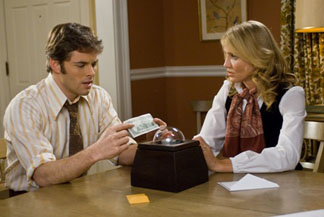|
|
Book vs. Movie: The BoxBy Russ BickerstaffNovember 9, 2009
The Movie Produced over two decades after the TV adaptation, the film sets the story in the rather narrow confines of Virginia in December of 1976. It's a retro contemporary style that's executed pretty well. James Marsden and Cameron Diaz play Arthur and Norma as a solidly upper middle class couple. He works at NASA. She's a schoolteacher. They have a son. It's all very quaint. The film wastes little time in setting up the plot. Arthur and Norma are in bed when they hear someone at the door of their relatively spacious home. She goes down to answer the door only to see a car driving away. A carton rests at the foot of the door. She brings it in. He opens it as she and their son have breakfast. The prop itself is actually quite classy looking. The button rests underneath a glass dome on an anodized aluminum plate on the top of a wooden box. It looks far slicker than its TV counterpart. The card that accompanies the button unit announcing Mr. Seward's imminent arrival is a large, wedding invitation-style affair with calligraphy and such. Mr Seward arrives — played here by Frank Langella. We find out in an opening bit of text that he had been struck by lightning, resulting in a rather nasty burn that is nonetheless very, very artificial-looking. The offer is more or less the same as it has been in previous incarnations of the story — except that the monetary reward in THIS particular adaptation ends up being $1 million — quite a bit in 1976. And it's kind of necessary here. With the family being solidly upper middle class, the money in question would HAVE to be more. Still, it loses something. We're bearing witness to the concerns of a family that isn't really struggling. Yes, she says they're living paycheck to paycheck, but they're both working decent jobs and living in a nice house. Money doesn't feel like as big a concern here as it is in the TV version.
[ View other columns by Russ Bickerstaff ]
[ View other Book vs. Movie columns ]
[ Email this column ]
|

|
|
|

|
Friday, November 1, 2024
© 2024 Box Office Prophets, a division of One Of Us, Inc.


